Oral history with Ellworth Dory, Edward Dory
An oral history interview conducted with Ellworth Dory, Edward Dory during Lakeland Heritage Weekend 2007.
An oral history interview conducted with Ellworth Dory, Edward Dory during Lakeland Heritage Weekend 2007.
An oral history interview conducted with Dorothea Ellen Houston during Lakeland Heritage Weekend 2008.
An oral history interview conducted with Julia Pitts during Lakeland Heritage Weekend 2008. Mrs. Pitts discusses her childhood in Beltsville, Maryland. How living in a predominantly white community affected her childhood, the relationships that existed in that community, and being educated in an all African-American, one room school house from first to seventh grade. Though she was born in Montgomery County, Maryland, where her parents met, they moved to Beltsville when she was young. She describes how her family lived on the "white" side of Beltsville, and how she walked to school on the other side of Beltsville, because the school in her community was only for white children. She discusses her relationships with white children in that community, how the community stuck together, and how she didn't feel the effects of segregation until later in life. She also discusses her different places of employment. After dropping out of school after seventh grade, to help her mother support the family after her father died, she worked as a nanny for people within her Beltsville community. She later got a job at the University of Maryland, through a contact in her community. She worked at the University on the housekeeping staff, a job she didn't keep for long, because she applied for a position with Prince George's County. She spent most of her life working for Prince George's county as a community aid. Mrs. Pitts explains segregation's effect on her life, on the lives of her two children, and on those who lived in the Lakeland Community. She discusses in detail a case of discrimination at a local bank, which prompted the NAACP involvement. She briefly explains how she felt about Urban Renewal in Lakeland, and how other people in the community felt about it. Her home was not affected by Urban Renewal but she understands how it effected others who lost their homes. A common theme throughout the interview was Mrs. Pitts' involvement in church groups and both the Baptist and Methodist churches in Lakeland. She is an active member of Church Women United, and mentions the organization several times throughout the interview.
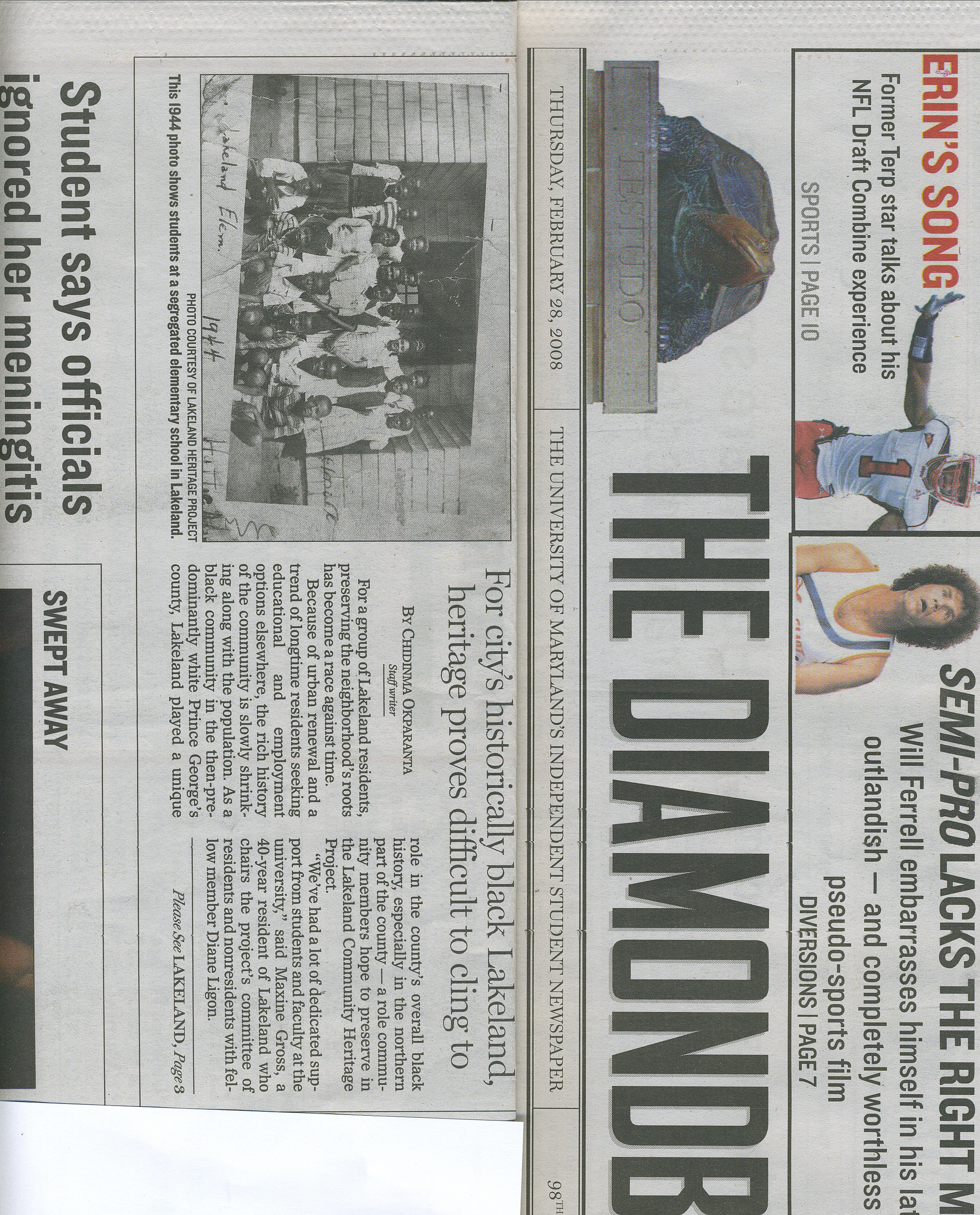
Diamondback Newspaper

Heritage Weekend Sunday with service on Lakeland Road. Standing is Rev. Edna Jenkins of Embry AME Church. Seated far left is Rev. David Barrozo pastor of Washington Brazilian SDA Church (Lakeland High School site)
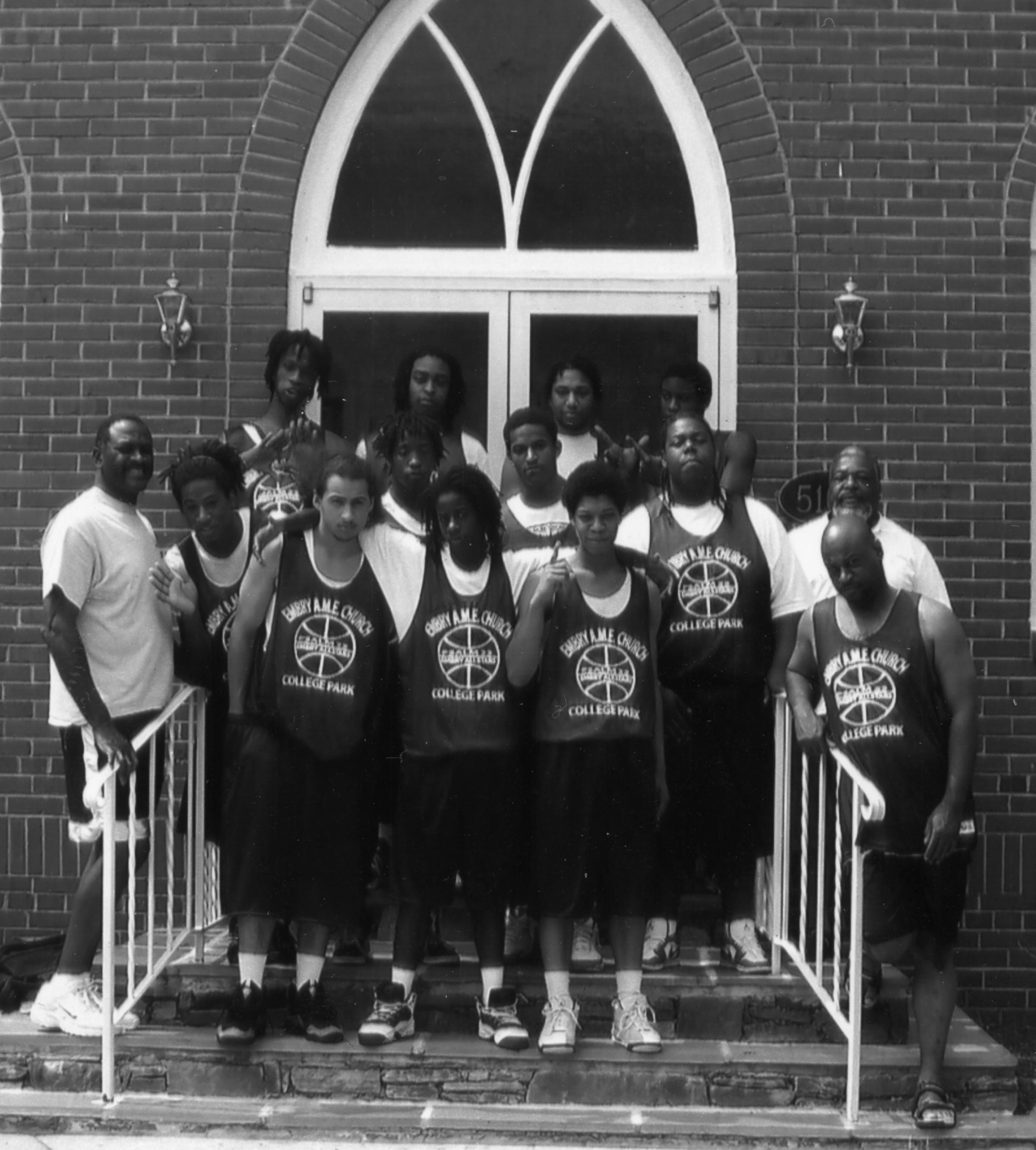
Basketball team sponsored by Embry AME Church with their coaches Earl Hawkins rear left in white shirt, Dwight Brooks right in white shirt and in front of him Reginald Gaskins
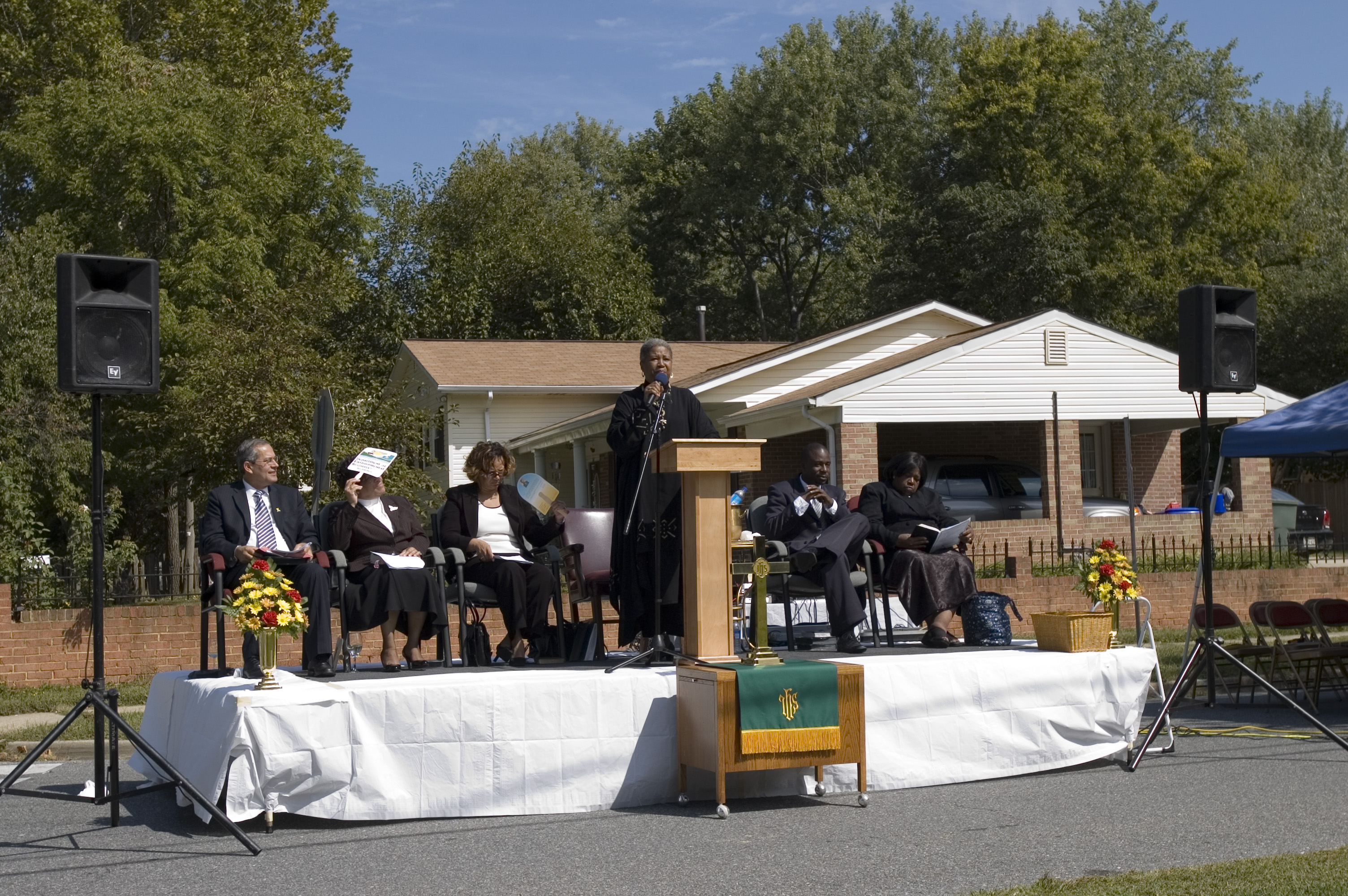
First Heritage Weekend Sunday service in crossroads of Lakeland. Representative of various Lakeland churches are on stage. They include left to right Rev. David Barrozo of Washington Brazilian SDA Church, unknown, unknown, Rev. Edna Jenkins, Rev. and Rev.
An oral history interview conducted with ? during Lakeland Heritage Weekend 2008.
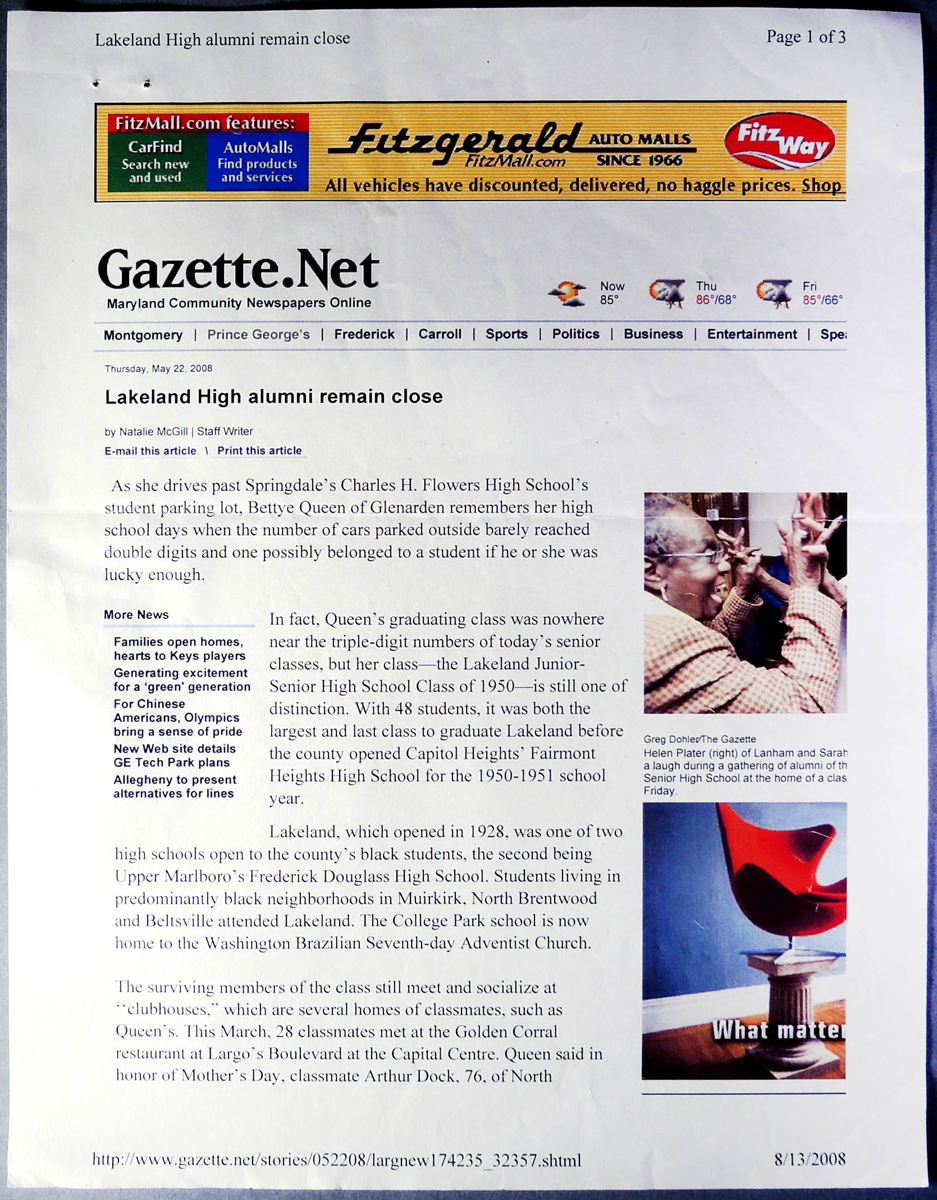

The Voices of Embry Choir performing during Sunday service as part of Lakeland Heritage Weekend on September 22, 2008. Choir members are, from left to right, Valerie Hill, Jeanette Williams, Abigail Cohen, Ethel Lockerman, and Diann Sims-Dwight. (Photograph courtesy of Christopher Anderson/The Gazette)
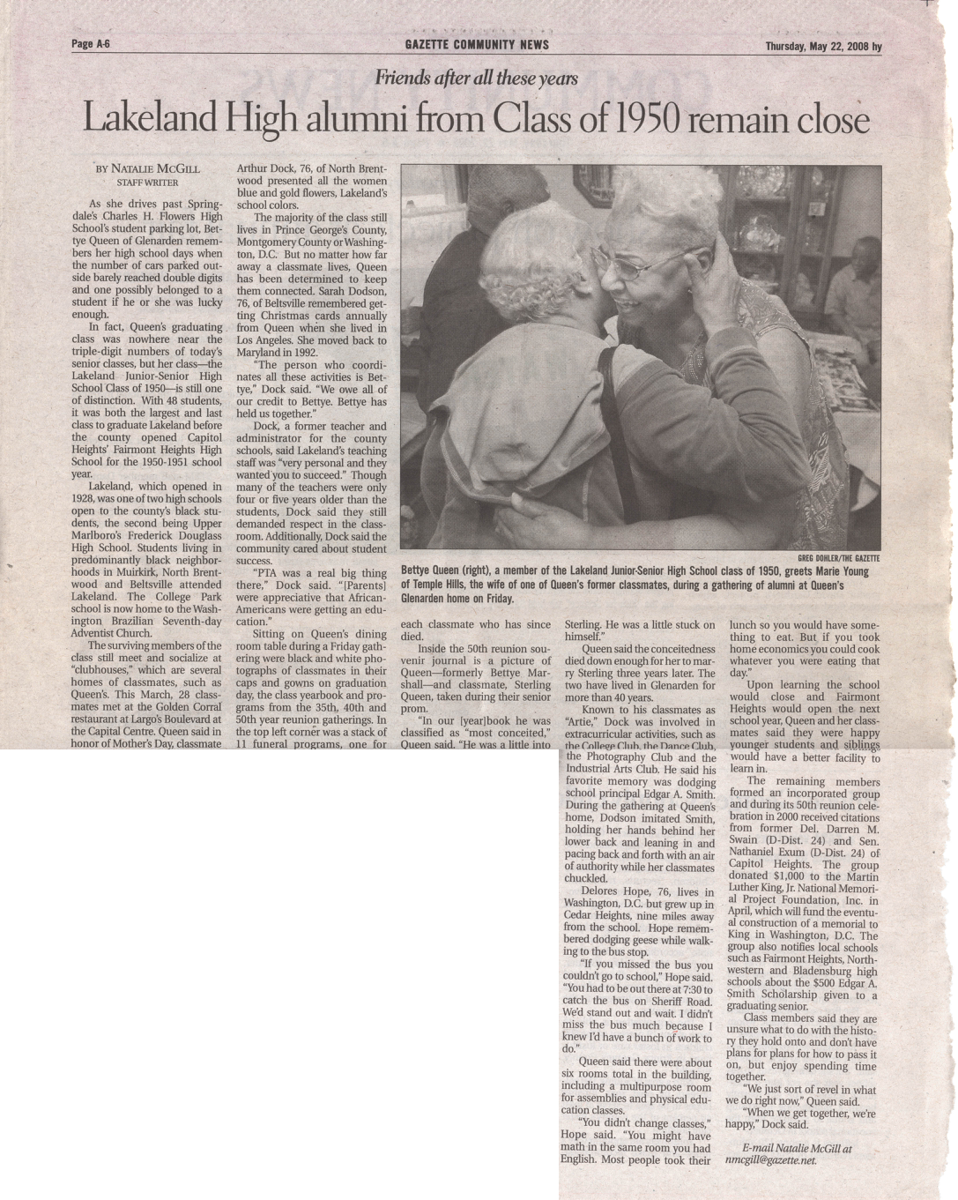

The Diamondback publishes a piece on urban renewal in the city of Lakeland. It highlight's the commitment of Lakeland residents to preserving the neighborhood.
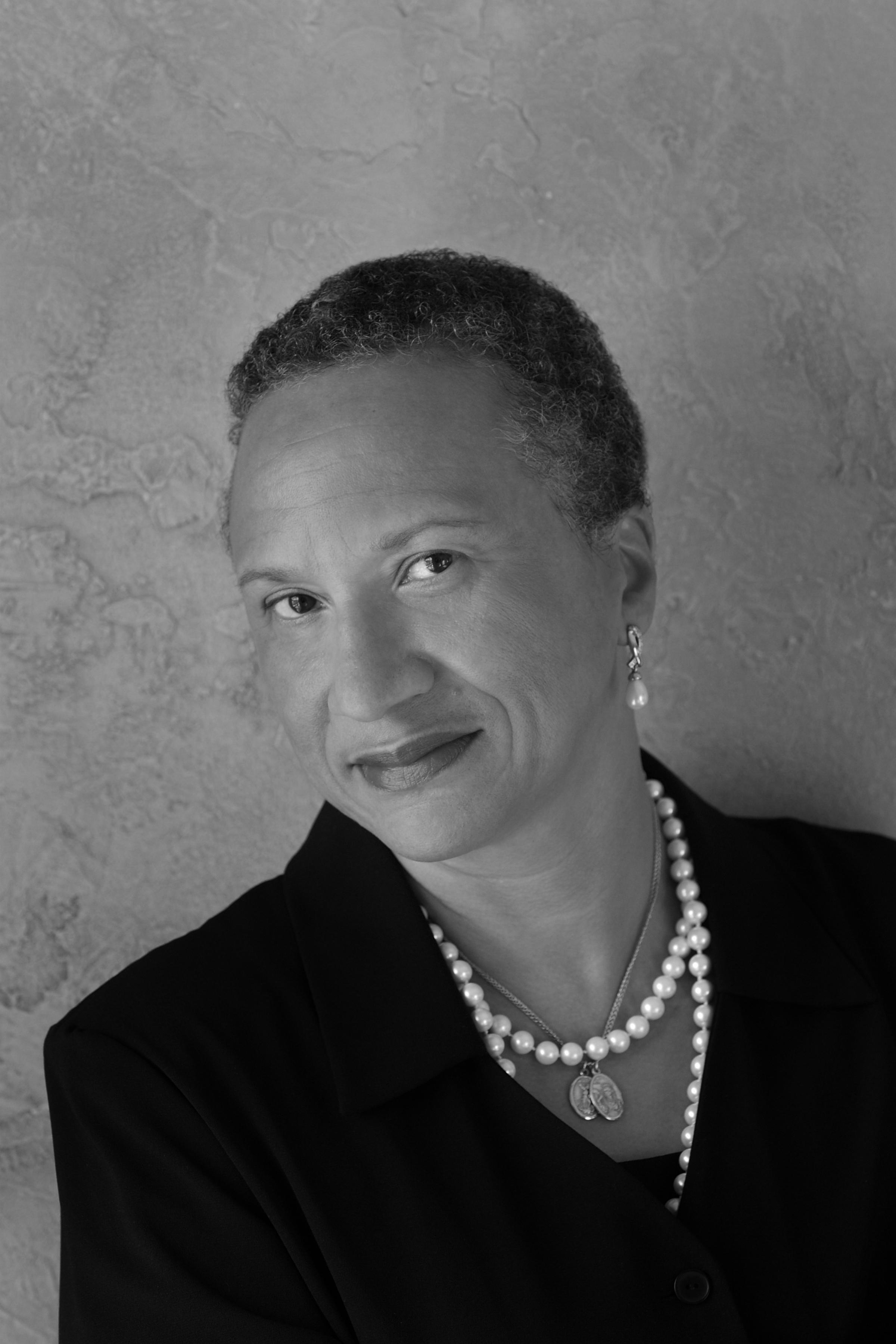
Joanne Margaret Braxton, the daughter of Harry M. Braxton Sr. and Mary Ellen Weems Braxton, is photographed here in 2008. Having earned her undergraduate degree at Sarah Lawrence College and her master's and doctoral degrees from Yale University, Dr. Braxton joined the faculty of the College of William and Mary in 1980. She is a widely published scholar and poet and has received numerous awards during her 29 years of service as a senior African American faculty member.
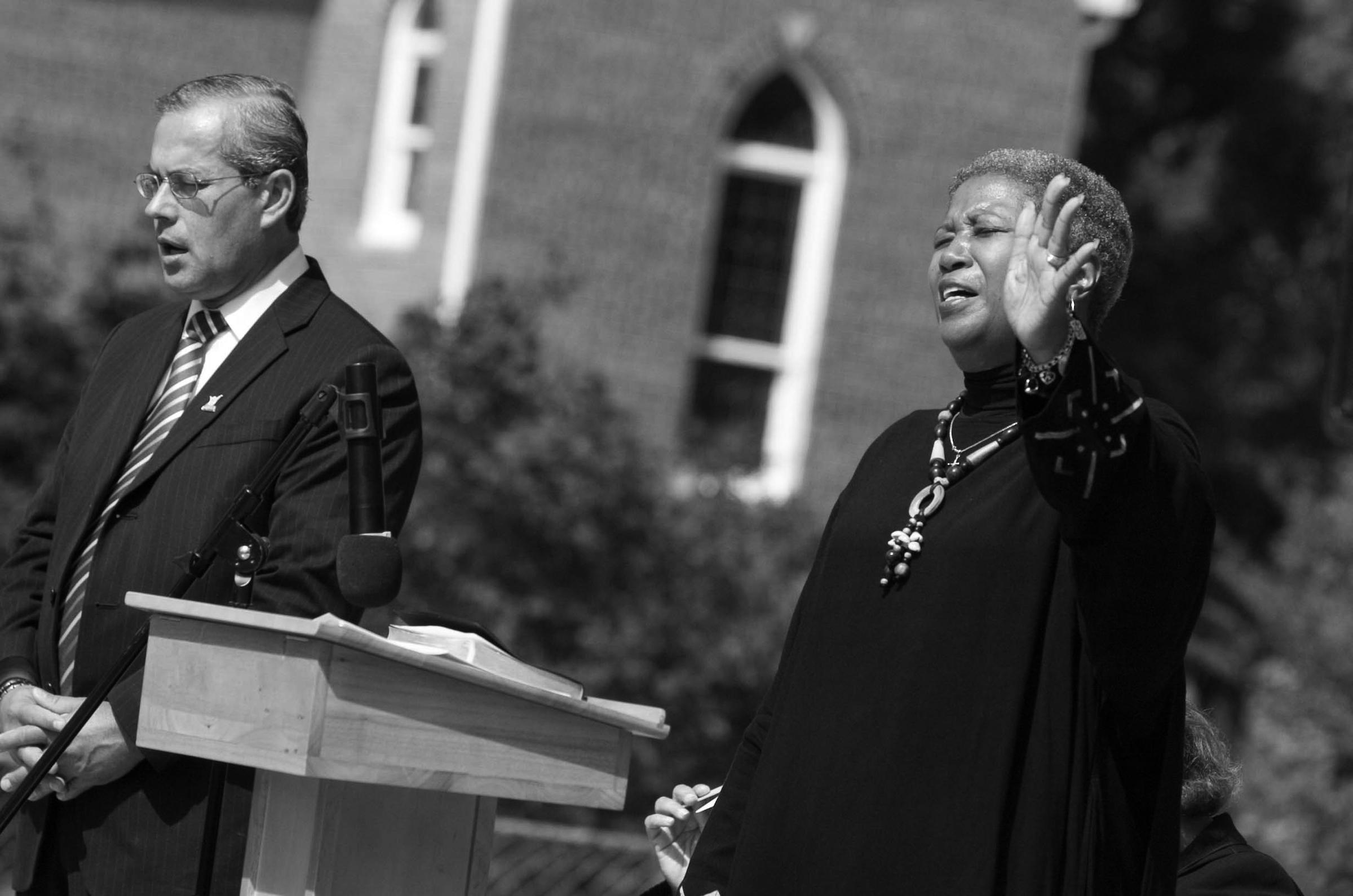
On Sunday, September 22, 2008, more than 200 people gathered at the “heart of Lakeland,” the intersection of Lakeland Road and 51st Avenue, between two historic churches, for Lakeland Heritage Day, a time of celebration and remembrance. The focus for that year’s celebration was the importance of religious life in the heritage of Lakeland. The featured event of the festivities was an outdoor worship service with participants from all of Lakeland’s churches: the First Baptist Church of College Park, the Embry African Methodist Episcopal Church, the Washington Brazilian Seventh-day Adventist Church, and the Salvation African Methodist Episcopal Zion Church. Pastor David Barrozo of the Washington Brazilian S.D.A. Church and the Rev. Dr. Edna Canty Jenkins of Embry A.M.E. Church were photographed during the event.
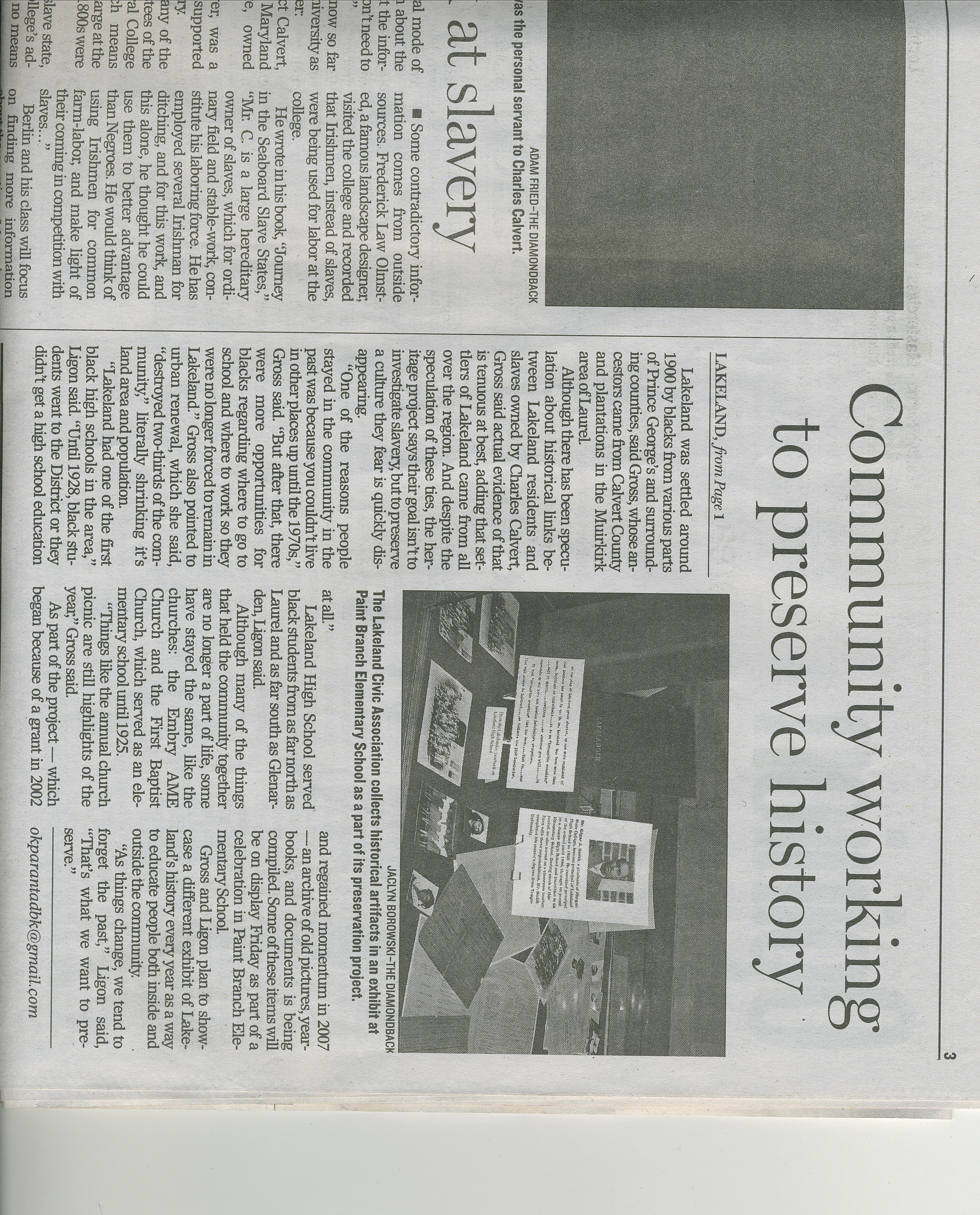
The community of Lakeland and its members want to preserve its history by and through LHP. The project members plan to display artifacts from collections every year and preserve the past.
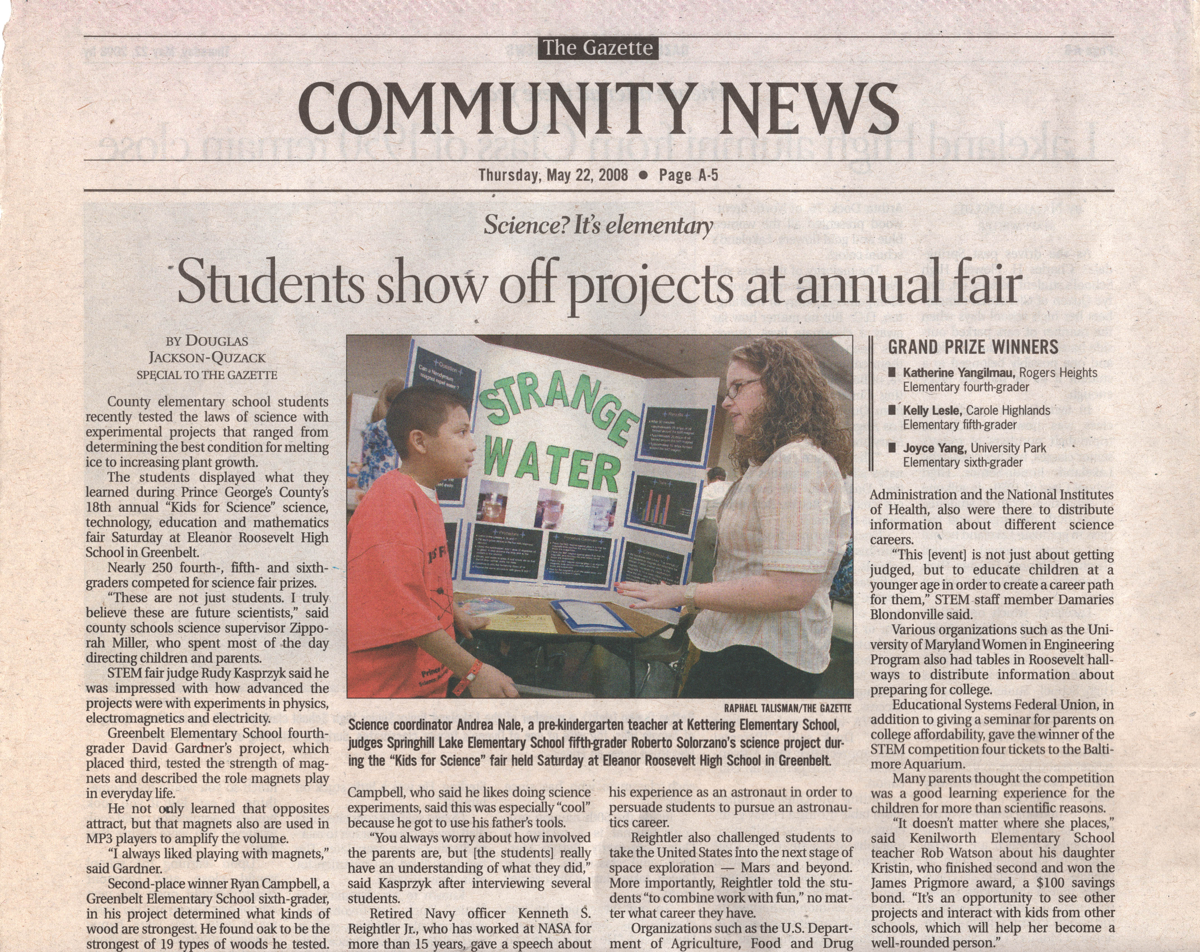

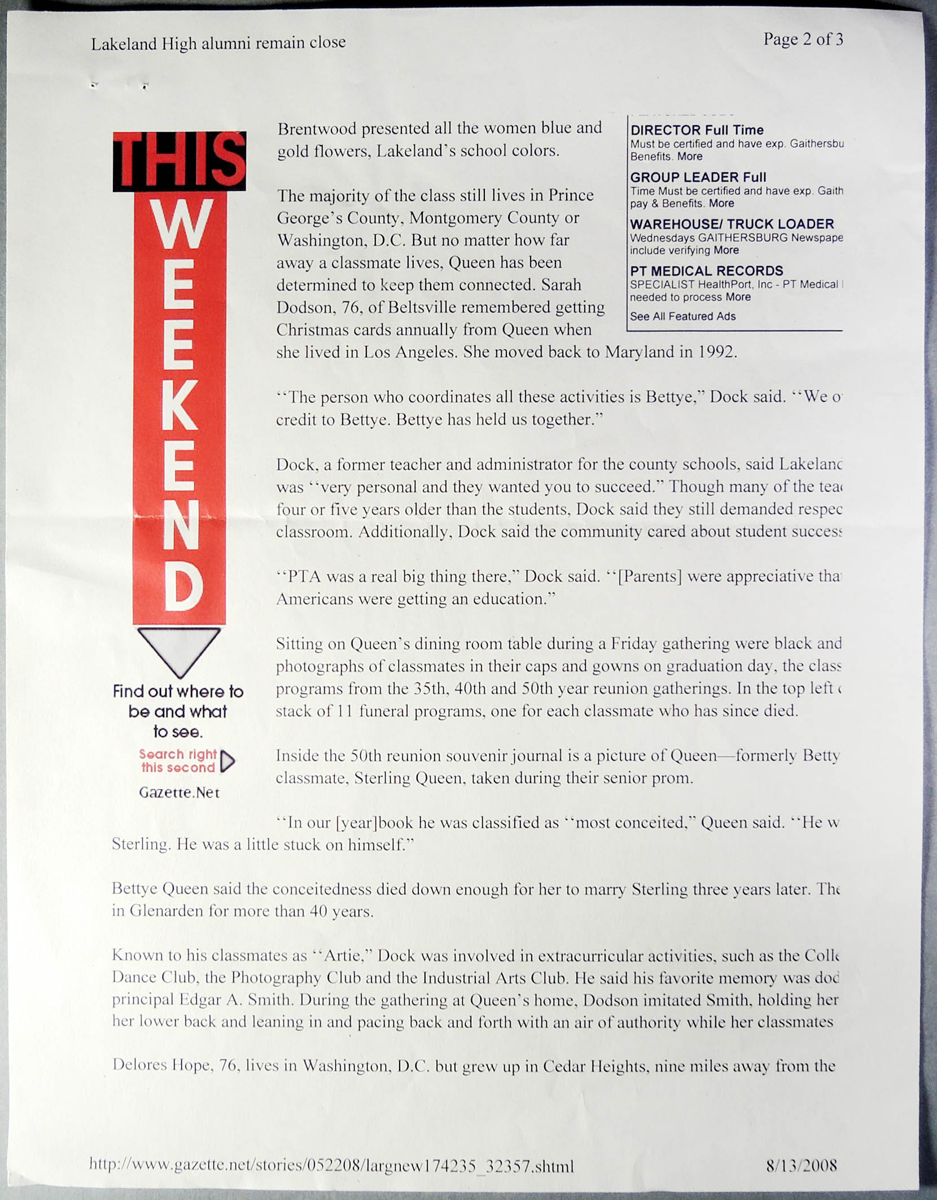


2009 Maryland National Capital Parks and Planning Commission signature Black History Month Exhibit at Montpelier Cultural Arts Center, Laurel, MD in the foreground is seen a silver service from the home of George Henry and Agnes Gross

Exhibit on Lakeland at Montpelier Cultural Arts Center for Black History Month by Maryland National Capital Parks and Planning Commission
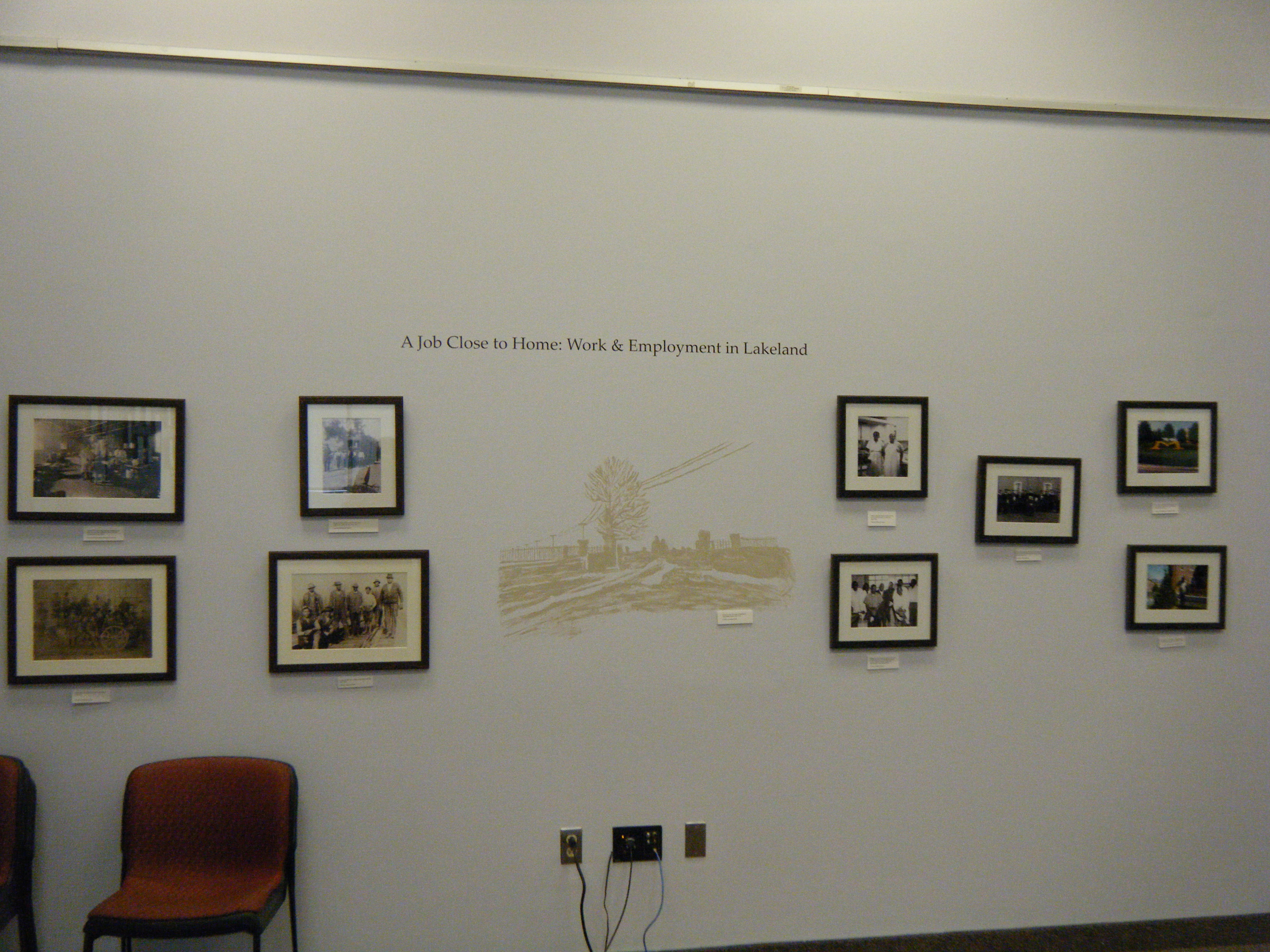
A Job close to home: Work & employment in Lakeland
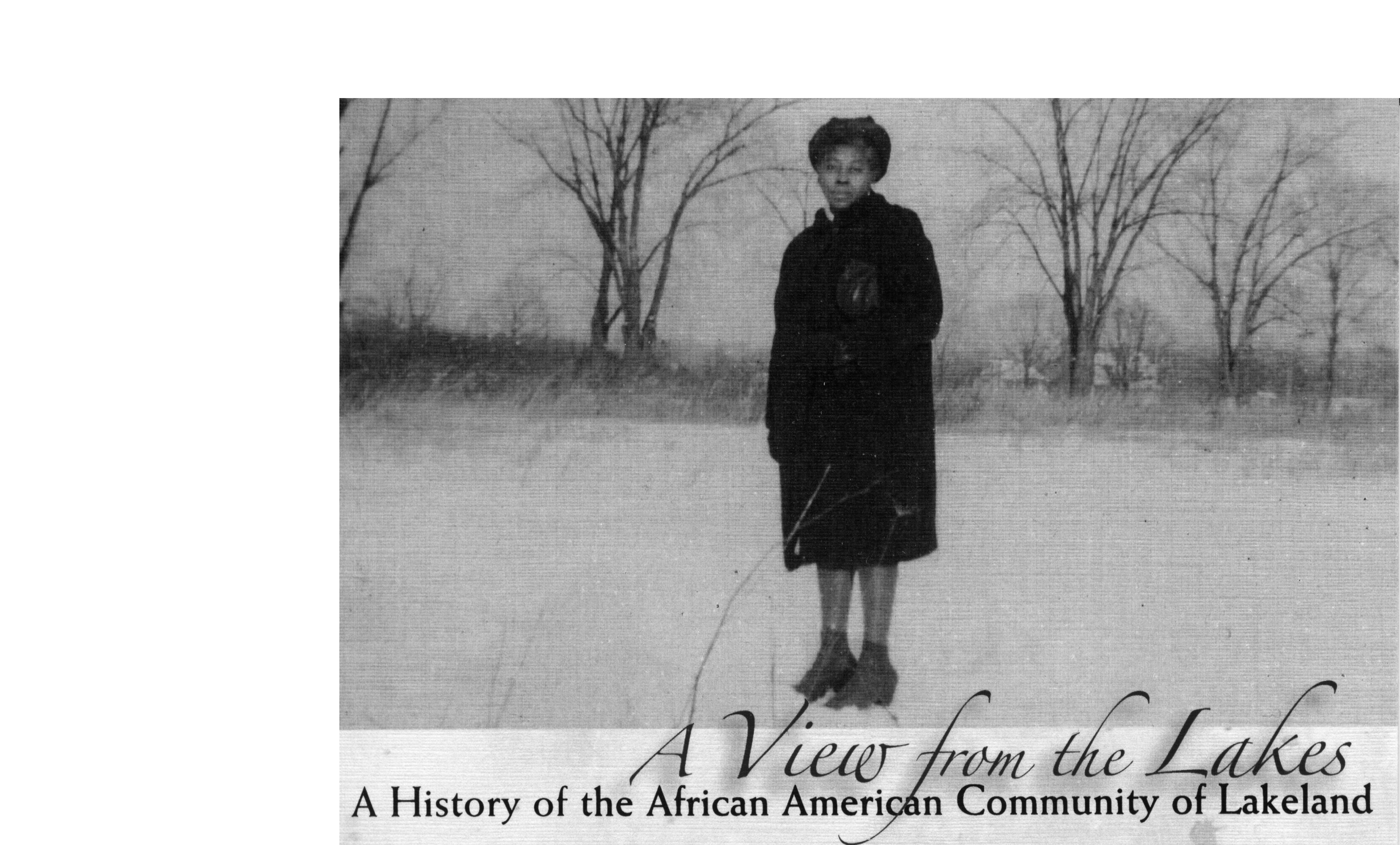
A View from the Lakes was an exhibition on the Lakeland community mounted by Maryland National Capital Parks and Planning Commission for Black History Month 2009. Image is of Agnes Harrison Gross

Images from a section of Exhibition

Wall from exhibition
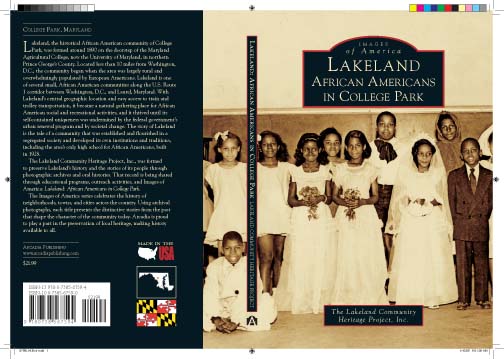
Lakeland: African Americans in College Park, Lakeland Community Heritage Project Published by Arcadia Publishing
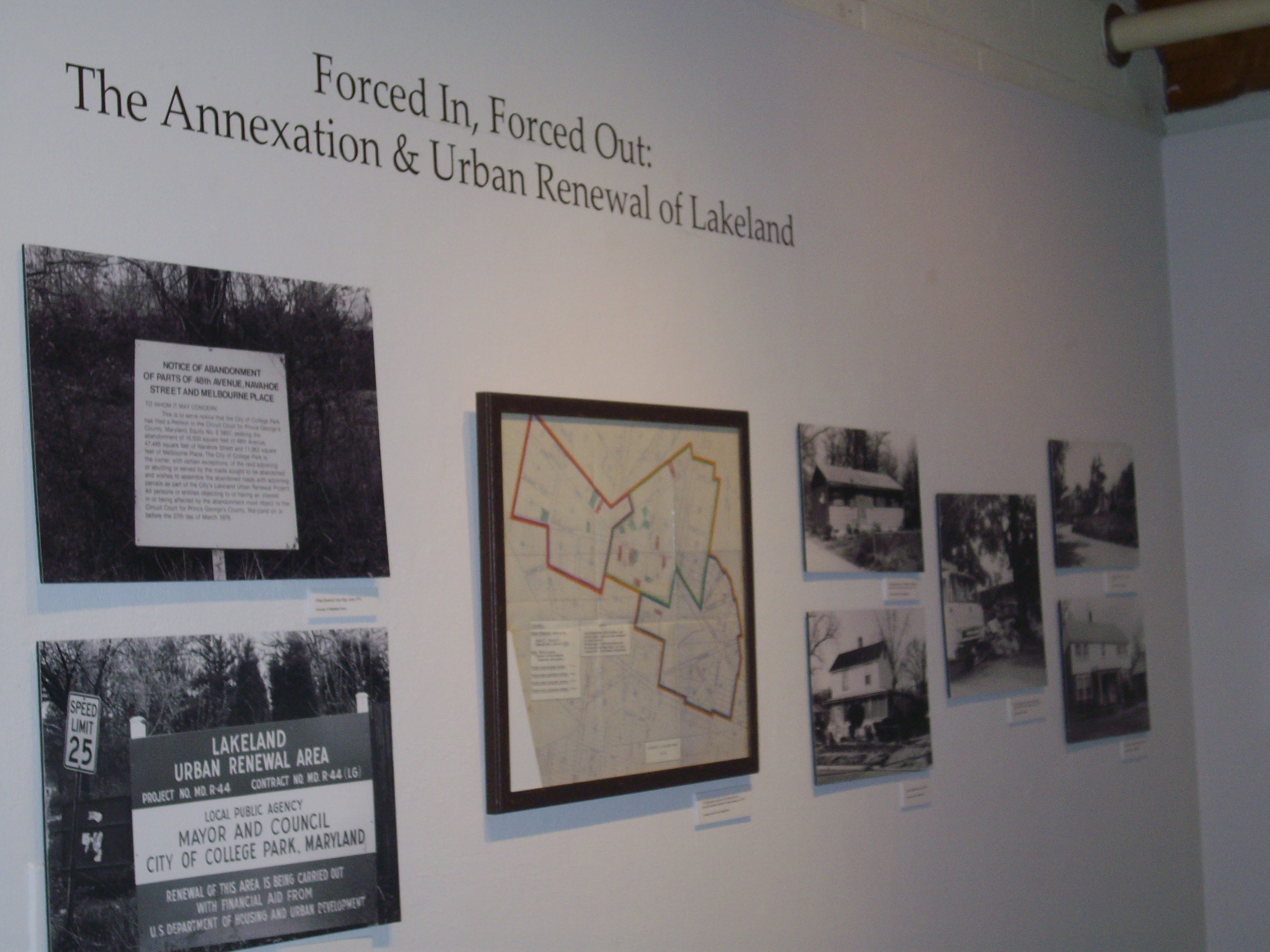
Exhibition section
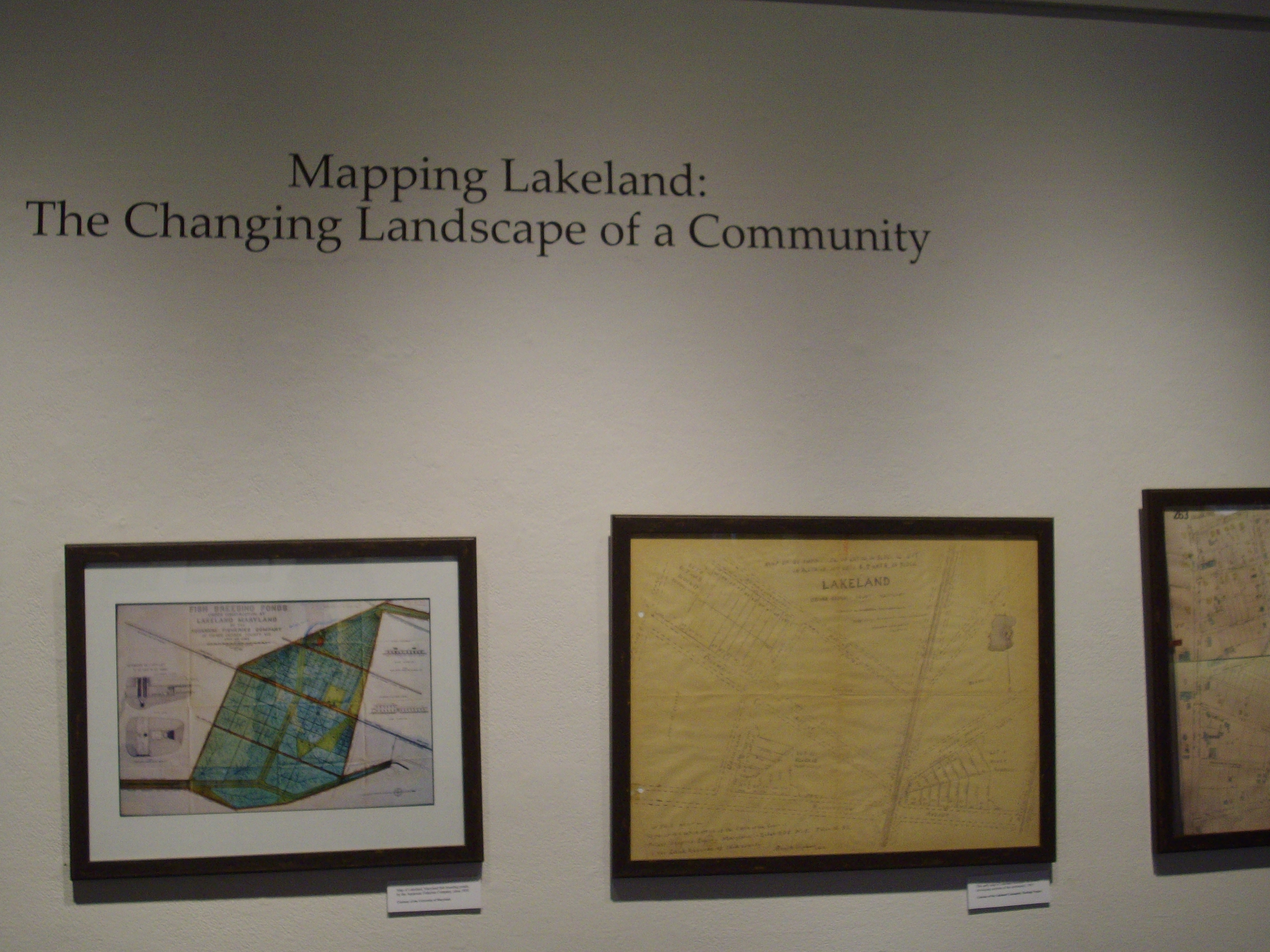
Exhibition wall

Exhibition section

During Heritage Weekend 2009 at College Park Community Center

Exhibition hall view
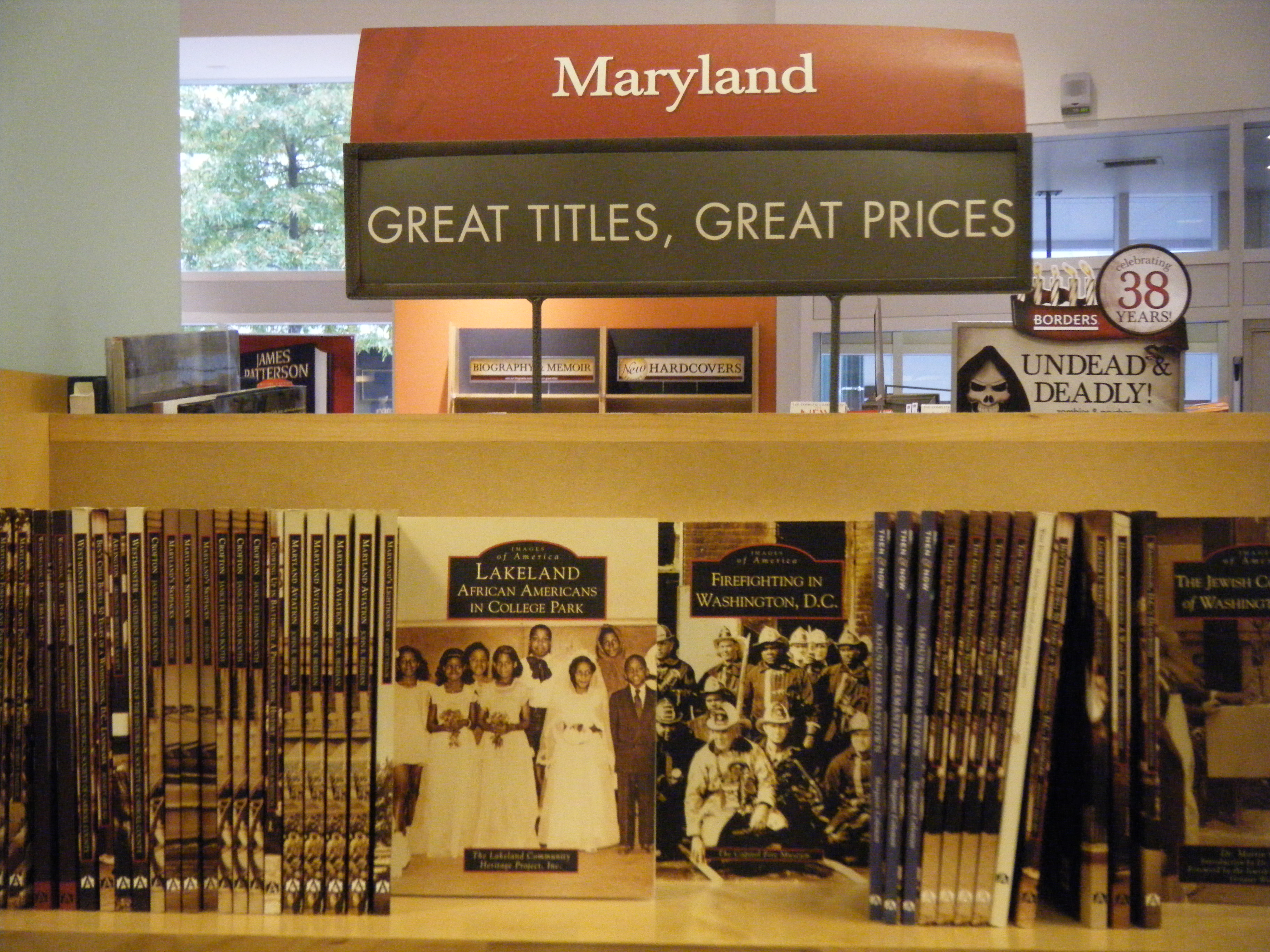
Lakeland : African Americans in College Park displayed in local book store

Exhibition wall
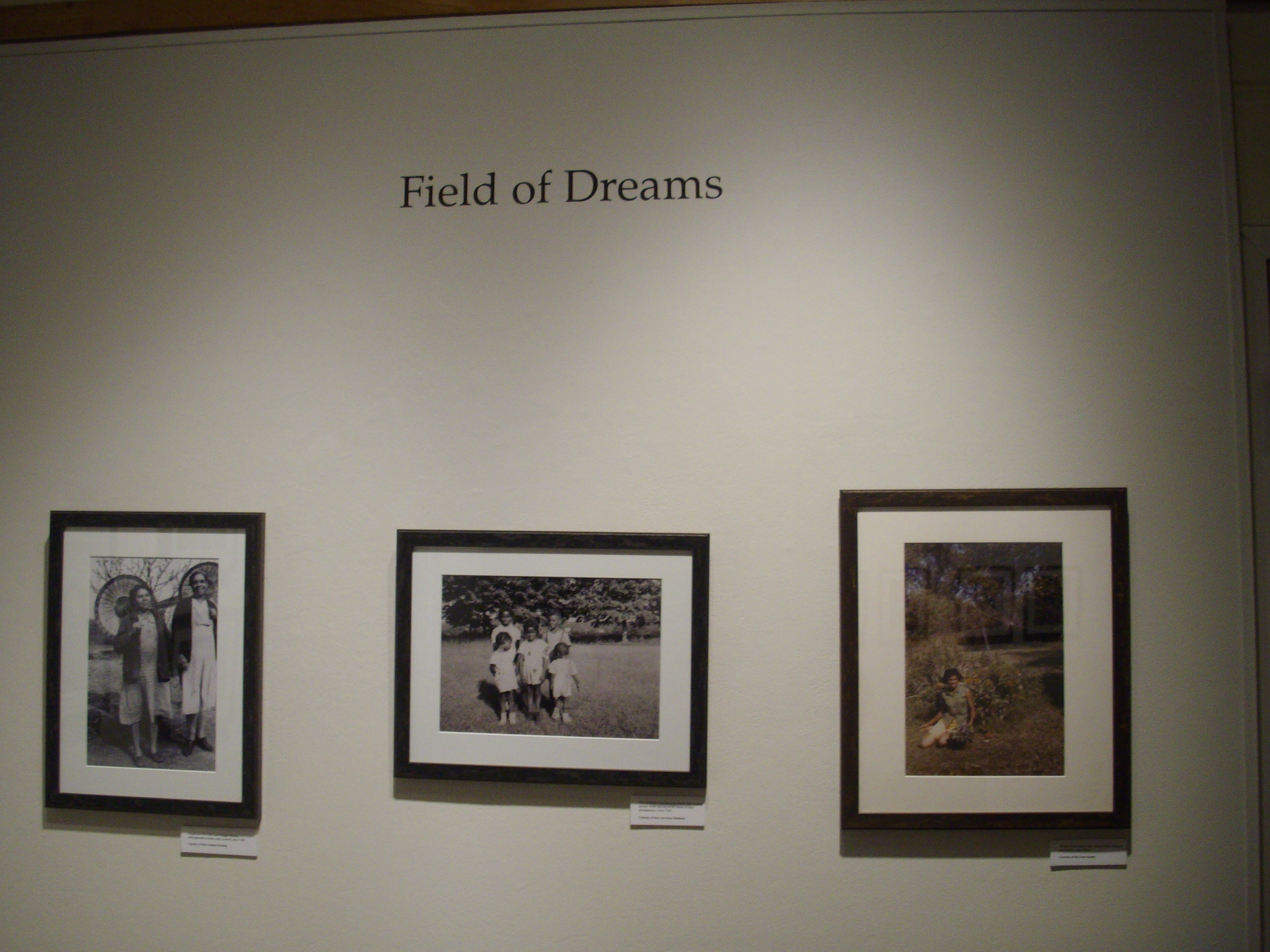
Exhibition

A Job Close to Home section of exhibition
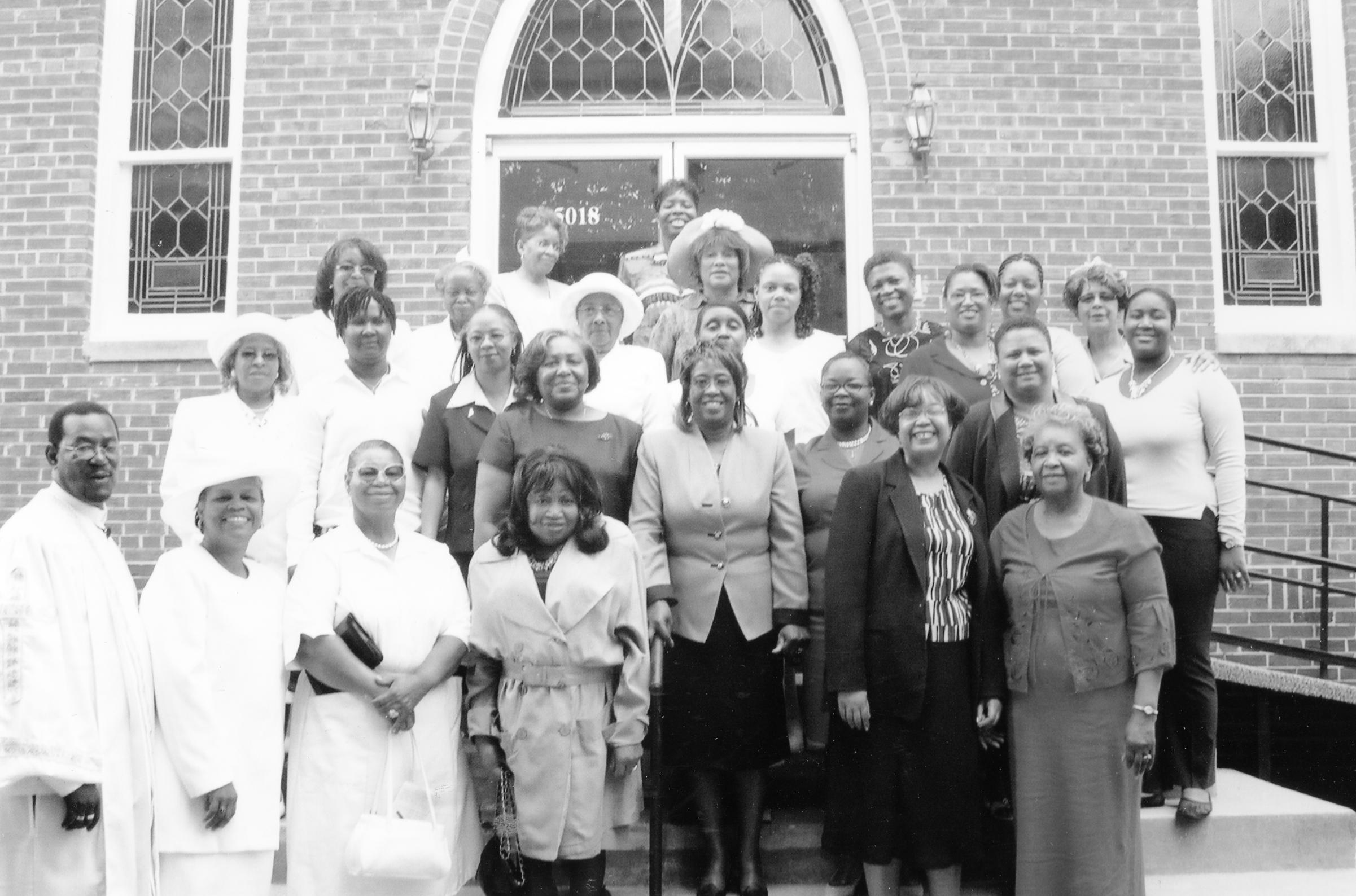
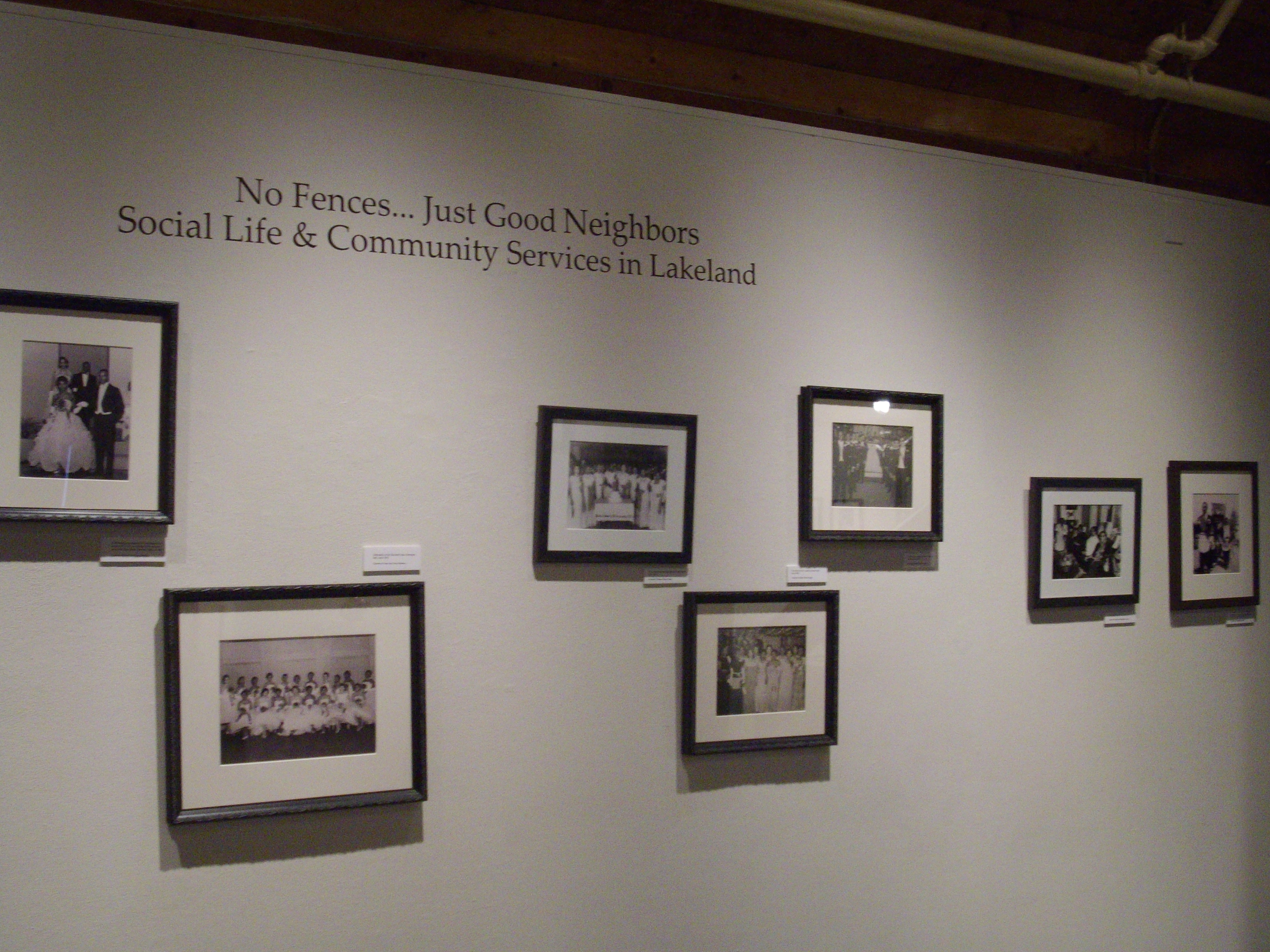
Exhibition section
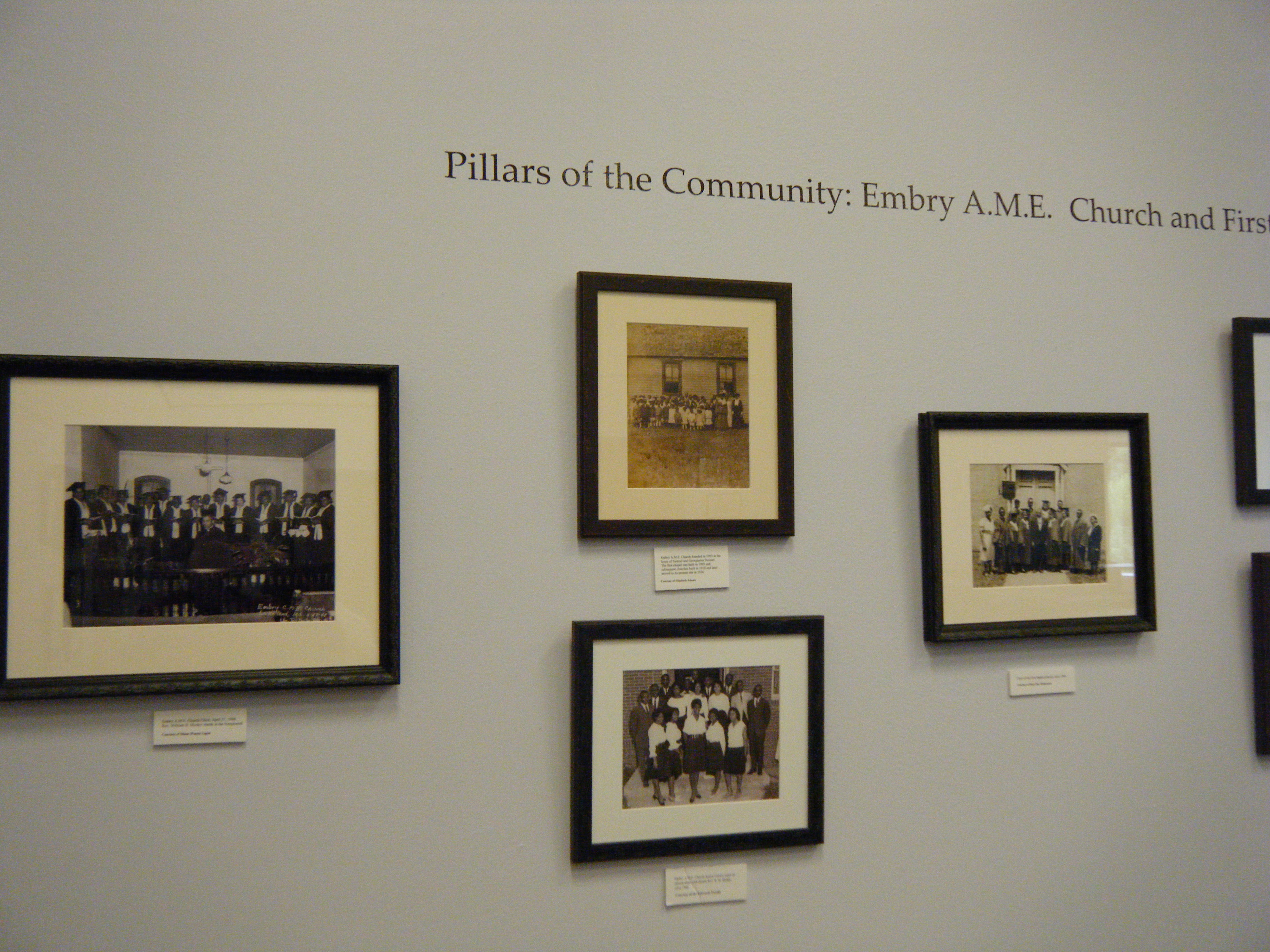
Exibition
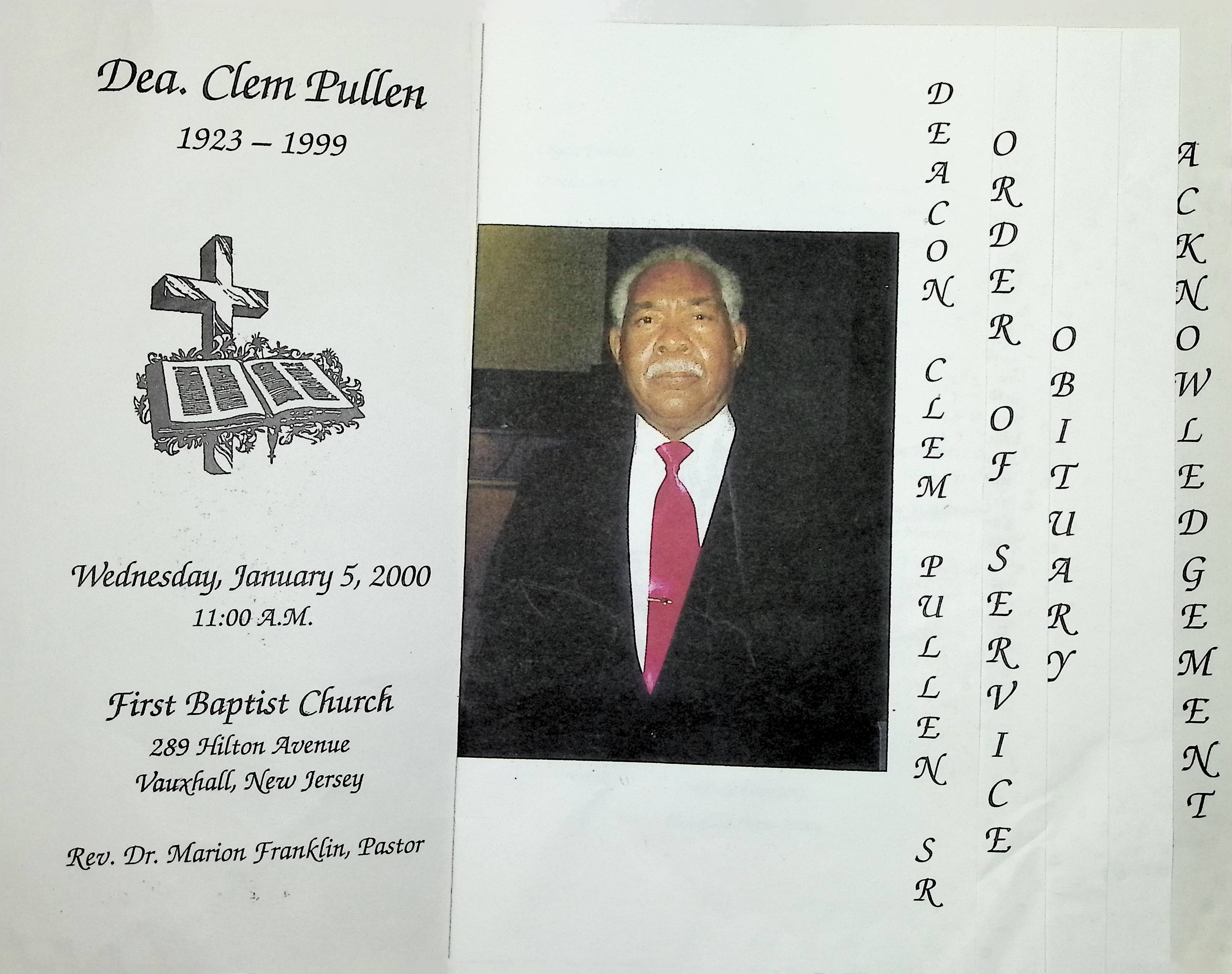
Exhibition wall
Oral history with Shirley Tyner-Pratt, by Brian Cuvo, Jennie Chaplin, and Gregory McCampbell, Capitol Heights, MD, December 14, 2009.

Exhibition case

The Lakeland Community Heritage Project worked with The Maryland-National Capital Park and Planning Commission to produce the exhibition, “A View from the Lakes: A History of the African American Community of Lakeland.” The exhibit was mounted at Montpelier Cultural Arts Center in Laurel, Maryland, in February 2009. Photographs and memorabilia were used to tell the community’s story, including the strong religious, educational, and cultural ties that evolved and have sustained the community for nearly 120 years. Photographs from the exhibition can be viewed in the Lakeland Room of the College Park Community Center, 5051 Pierce Avenue.

Exhibition wall

Baker, Willie Sellers Greets Lakeland elder, Leonard Smith during Lakeland Heritage Weekend Saturday Event in 2009

Exhibit at College Park Community Center
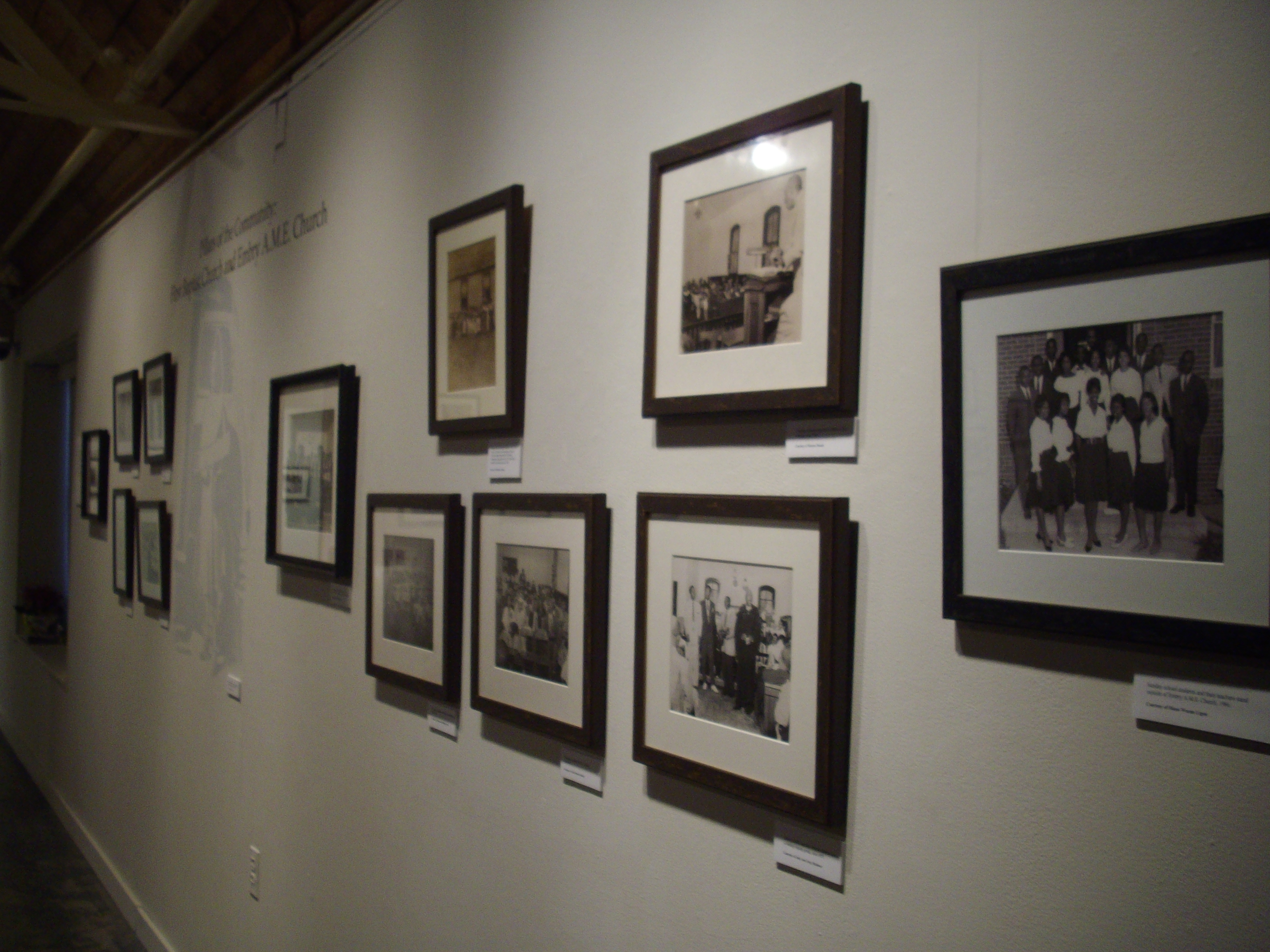
Exhibition wall

In Lakeland
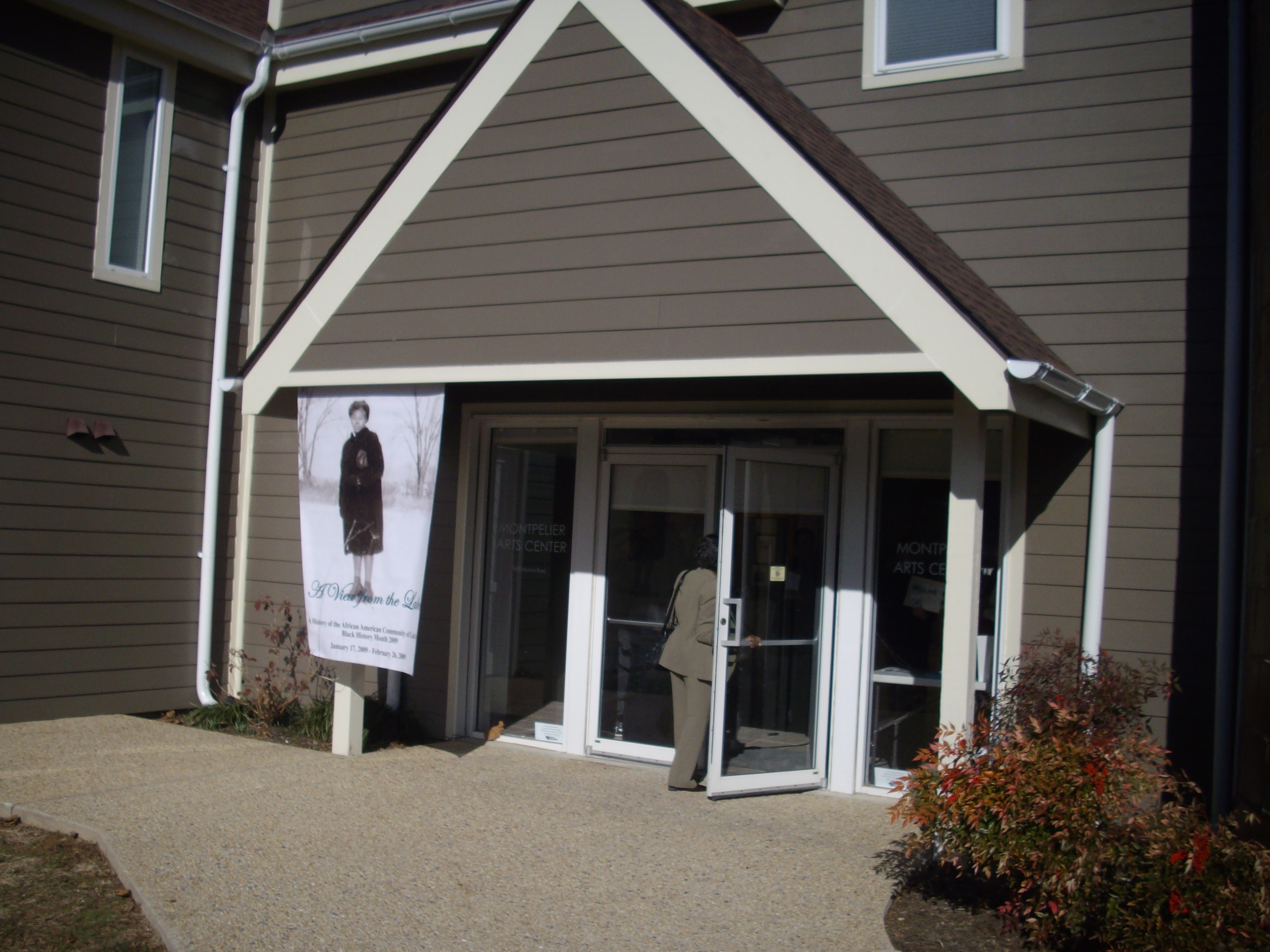
Shown with banner advertising A View from the Lakes

View from the Lakes
Violetta Sharps Jones, with her infant grandson, was interviewed on November 18, 2009. After not knowing her maternal or paternal grandparents, Violetta became interested in her genealogy. She is able to trace back her family's roots in Lakeland to the early 1900s. Her family migrated from Colonial Beach, VA in Westmoreland County to Washington, D.C and she was able to determine through census records that in 1880, Sarah Walls migrated to Washington, DC where she worked as a servant for a doctor and his family. This doctor was also from Virginia, so it is possible that she came with them to Washington, DC. She believes that Sarah's mother, Susan Walls moved to Lakeland because her children were there, and when she died in 1906 her body was sent back to Colonial Beach, VA to be buried, most likely because that is where her husband was buried. The 1900 census documented that Sarah, the oldest daughter, and her sister Nanny Walls, who was Violetta's great grandmother, lived in Lakeland. Nanny Walls Johnson Tate lived there with her husband James Johnson and their five children, and their family owned their home in Lakeland after 1900. Violetta was born in 1948 and lived at 1425 Albany Avenue, Lakeland, MD. When she left Lakeland in 1975, she lived at 5507 Albany Avenue, Lakeland, MD. Four generations of her family had lived in Lakeland since the 1900s. She was able to recall the neighbors that she grew up around, including John and Maggie Brooks who had five children, James and Martha Edwards who had one child, Charles and Netty Hamlet, and James and Anna Smith who lived in the building that used to be the Rosenwald School with their thirteen children. This school was comprised of two large rooms that previously housed the classes, a hallway, kitchen and storage room. Violetta's experience living in the East Side of Lakeland remained rural, and she was able to recall lots of outdoor activities and cookouts in her neighborhood. Her father was in the cooking profession and worked as a chef at the now closed College Park Diner that was located where the current McDonald's is, at a restaurant in College Park, and at one point he owned a small restaurant in Alexandria, VA. During the summer he would dig out a pit and have a barbeque pit, and Violetta recalls that her father always had an entrepreneurial spirit. Violetta grew up in her Family's house and recalled that her mother raised two of her sister's children after her sister passed away. Her extended family did not live with her; however, she recalled that at times relatives would stay with her family for one reason or another. Members of her extended family lived in the area local to Lakeland, and they were all associated with Embry AME Church together. Growing up, Violetta lived in a two-story house with a wrap around porch. Her house had two front doors with one door shut off to a parlor that was only used for special occasions. The siding on her house was originally wooden but then aluminum siding was installed. Next to her house was a large yard with an apple and walnut tree. Violetta later got married under that same walnut tree. Additionally there was a fishing pond with no fish and flower garden in her yard as well. Her family did not have a vegetable garden because of her Dad's work schedule and because she had no other brothers to upkeep it, nor did they keep any animals in their yard. The layout of her house consisted of a huge dining room, which activities were centered around, four bedrooms and an indoor bathroom on the first floor that was installed after the house was build because the original house did not include indoor plumbing. Violetta recalled the architecture styles of the houses around her, with several houses having a resort style, a large Victorian near the lake, a Bungalow style house with a screened in front porch, along with two-story structures that did not have a porch, and a cottage. Most houses in the area were fairly large two story structures. Status was not placed on homes and Violetta described it as a proud not pretentious community. Since her father was the cook of the family and her mother never had to cook, her mother was interested in personalizing her house through its dacor. Growing up, Violetta did not think of her area as the East side instead it was just the other side of the railroad tracks. Social events growing up included house parties, events at Lakeland Hall that anyone could rent, Church events and the Friday night teen club held by the recreation department. The Teen Club took place at Lakeland High School, and they would occasionally join up with other recreation departments in Prince George's County for events. Another past time included dancing to Juke boxes in Black's store and buying penny candy. During the summer, the recreation department had organized sports including softball and swimming. Violetta attended Lakeland Elementary and Junior High School and at the end of her eighth grade was the beginning of integration. Violetta had the choice of attending Northwestern, High Point, or Fairmont High School, and ended up attending Fairmont High School, which was a thirty-minute bus ride to school. She very much enjoyed her school experience because her teachers had a vested interest in the students. The Embry AME Church was a focal point in her family's history, and her mother was married there and her extended family were members of the church. The ministers lived in Washington, D.C and loved Lakeland, and would spend their Sundays after church with different host families that would invite them to Sunday family dinners. Growing up in Lakeland there was always a sense of community and belonging for Violetta. Everyone knew each other, and new people would become a part of the community as well. The community members were very protective, and this was apparent in the way they cared for you. Lakeland was a safe place and no one locked their doors, and she recalled very few instances of break-ins. Looking back she realized that struggling families were supported by community members and they always had something to eat and clothing to wear and other families always stepped up to help. Very few families moved in to the Lakeland community, and most property was passed on to extended family instead of being sold when someone passed away. Some of the traditions that Violetta recalled from her childhood were that very few people did not go to church, which is something that has changed now. Now there are a lot of new people in the area with no connection to the town, and not everyone knows their neighbors. Growing up everyone knew everyone and their families, which was a bond of the community. People often married other community members from Lakeland or North Brentwood. The community boundaries of Lakeland were based on a social life with the neighboring black towns until the 1960s, and that segregated socialization was a choice not by force. Violetta recalls going to the library and shopping center in College Park, and that many of her friends were in Lakeland and neighboring communities. Violetta briefly discusses an engineering firm that opened up on the East side of Lakeland, but it did not become a part of the community. On the east side, there was one newer structure built, but the rest of the houses were from the 1900s. On the west side, many families had expansions to their homes throughout the neighborhood.